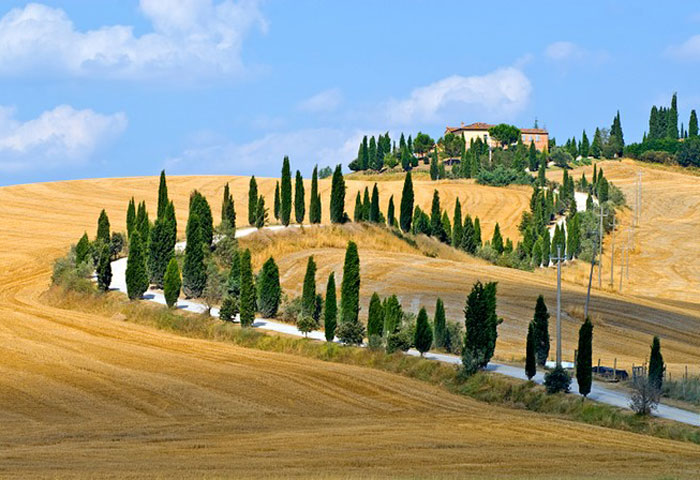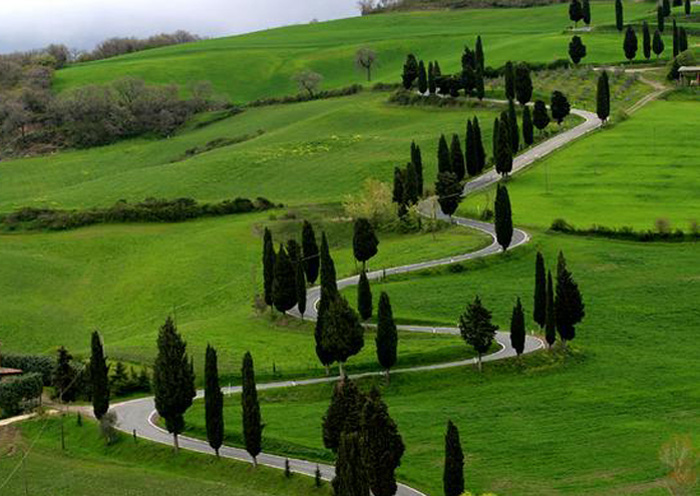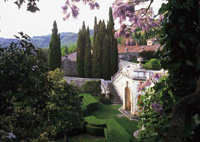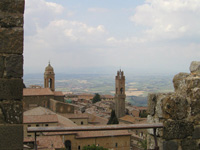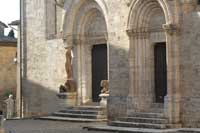Villa La Foce
When Antonio and Iris Origo bought the estate of La Foce, they engaged the English architect Cecil Pinsent, who had previously done extensive work on Bernard Berenson's Villa I Tatti in Florence, to restructure the main buildings and create a large garden. The latter was conceived to enhance the Renaissance house and expand the spectacular view over the valley of the Orcia and the Amiata mountain. The harmony between buildings, garden and nature makes La Foce an ideal example of Tuscany's architectural and cultural evolution in the XXth century.
Gardens in Tuscany | The gardens of La Foce

Podere Santa Pia, one ot the hidden secrets of southern Tuscany, sits undisturbed in some of the most beautiful hills of Tuscany enjoying breathtaking views of the surrounding Maremma hills. Its hillside setting affords stunning views stretching from Monte Amiata across to the islands of Elba and Montecristo off the coast. The peacefulness of the countryside, the various unique villages and the friendly atmosphere will no doubt pleasantly surprise you.
Podere Santa Pia is located on the edge of the green hills of the Val d'Orcia and the Valle d'Ombrone begins, and one can easily reach some of the most beautiful attractions of Tuscany, such as Montalcino, Pienza, Montepulciano and San Quirico d'Orcia, famous for their artistic heritage, wine, olive oil production and gastronomic traditions.
Farmhouses in Tuscany | Podere Santa Pia
|
The landscape ot the Val d'Orcia as it unfolds nowadays was created by wealthy Siennese merchants in the 14th and 15th centuries. The farms cultivate mainly grains, vines and olives. Rows of cypresses are also a distinctive sight. The beauty of the area inspired Renaissance painters and early travellers on Via Francigena.
Monticchiello
Monticchiello is a small centre in the heart of the Orcia valley whose beauty derives from its geographical position and the harmonious integration of its medieval architecture, and wide, well-proportioned spaces, which give the impression of moving around a great house. Closer examination will reveal many points of interest for the visitor, and we invite you to read our suggestions and proceed without hurry to appreciate the evidence of the town's past, and recent history.
At a distance, Monticchiello appears simply as a tough, squat tower on the crest of a hill. The remains of its formidable walls and the medieval city gate are only visible to visitors when they are almost beneath the castle.
The town's beginnings are lost in time, but if we consider it of Roman origin, we can imagine it belonging to the Gens Cloelia, deriving the name Monticchiello from the Latin, "Mons Cloelii".
Probably Monticchiello was included in the list of castles, which Lamberto Aldobrandeschi ceded to the Badia Amiatina in 943.
In 1156 however, it was given in feud to Pope Adrian 1V by Count Paltonieri.
Despite the castle's name appearing in such ancient documents, the history of Monticchiello begins to acquire importance only at the beginning of the XIII century. The population, tired of the abuse of administrative power by the Teutonic Knights (who had obtained the castle in feud from the Church of Rome in recognition of their defence of holy sites) decided to side with the Republic of Siena, becoming its most faithful ally. The first document relating to the free Commune of Monticchiello is dated 1243. From this moment began the most flourishing and glorious period in the castle's history. With the completion of the keep, the walls and the church, crafts and commerce began to develop. Agriculture improved and the population increased, together with a sense of community and civic conscience. The Commune published its statutes in Italian, and the people took an active part in political life making their own voices heard through the "Council of one for each family".
The Franco-Spanish war, which broke out in 1500 marked the end of this independence, and on 15 th August 1559 the inhabitants were finally consigned to Francesco da Montaguto, the plenipotentiary of Duke Cosimo Dè Medici – having bravely resisted a long and bitter siege.
There inevitably followed a period of extreme decline in which commercial activity and the trades stagnated. In the countryside, the sharecropping system was introduced little by little, and public institutions lacking renewal progressively broke down, until, on 26 th June 1778, the Granduke Pietro Leopoldo decreed the suppression of the Commune of Monticcheillo, and placed it under the jurisdiction of the Commune of Pienza.
For Monticchiello the Risorgimento was only a distant echo, and even the unification of Italy failed to bring any significant change. During the First World War, Monticchiello paid a high price in blood for the country, with 31 deaths out of 750 inhabitants.
The character and tenacity of the townspeople showed itself most particularly in the spring of 1944. On the 6 th of April, Dr. Chiurcho, the Prefect of Siena during the Fascist Republic, acting on information received in the Prefecture, decided to dispatch all his available men – around 450- to Monticchiello, to confront a small but strong group of Partisans camped around the town. After a long battle the Fascists were forced into a chaotic retreat. The next morning at dawn, a German division reached Monticchiello with precise orders to scour the territory and shoot the inhabitants. The soldiers broke into the houses, rounded up the people and lined them up against the wall outside the town gate for execution. The terrible slaughter was avoided thanks to the intervention of Irma Angheben, the German wife of one of Monticchiello's landowners, and the help of the priest, Don Marino Torriti. The event is now commemorated by a monument created by Emo Formichi, placed on the very wall intended for the executions.
Today, an heir to an ancient and long-remembered solidarity is the Teatro Povero, the 'Poor Theatre', a most impressive and clear sign of the town's vitality, and the people's capacity to rediscover and reaffirm themselves in a public space, confronting themes of great contemporary significance. Every year a new production, 'written, conceived and directed by the people of Monticchiello' returns to speak of past, present and future events of this community.
Most recently born is the Museo del Teatro Populare Tradizionale Toscano, - the Museum of Traditional Tuscan Popular Theatre- which functions within the aegis of the Siena Museums. This displays, in a fascinating and innovative exhibition installation, the places, images, sounds and symbols of this artistic form, so deeply rooted in Tuscan tradition.
Rocca and Town Walls of Monticchiello
The castle, or better walled town, of Monticchiello, fief of the local family of the Lambardi, was thickly strengthened from the Senesis at the end of the 12th century, when it became an important borderline fortress. Monticchiello was the main center of the defensive organization on the oriental border of Siena and so during its history was often object of wars and assaults, destruction and occupations. In the years 1229-35 the town was destroyed by the Orvietani,then at the to end of the 1300 it was occupied first by the Florentine and then by the Montepulcianesi and suffered others serious devastation in 1553, founding itself on the road of the Imperial army during the 'War of Siena'.
The whole system of the fortifications is chained to the Rocca, set in the highest point of the hill where the hamlet rises.
Only the mighty keep, built in 1260, with its bastioned walls endowed with machicoulis in stone (opening between corbels of the parapet through which the defenders can drop rocks or fire projectiles against an enemy directly below them) remains. The Rocca is private property.
The town walls are instead for great part preserved, reinforced by towers of various dimensions and shapes. Seven are the towers that we can admire today, two rounded flanking the S.Agata Gate (the only main entrance, several postern can be seen on the walled circuit) and other five square towers located in various points on the walls.
The village inside the fortifications has maintained intact its medieval characteristics and walking for its alleys is like 'breathing' Tuscan medieval life.
How to get there
Monticchiello is part of the council of Pienza, in the province of Siena. It can be reached following the motorway A1 up to the exit of Valdichiana and following the signs for Pienza or alternatively from the Val d'Orcia, first following the road SS2 Cassia until the crossing with the SS146 for S.Quirico D'Orcia.
|
